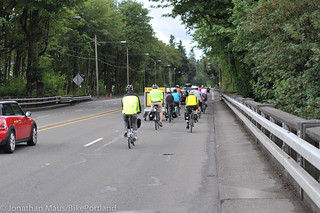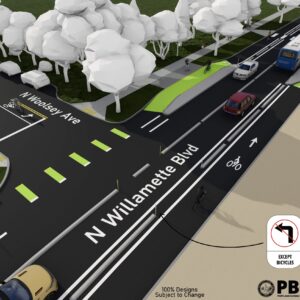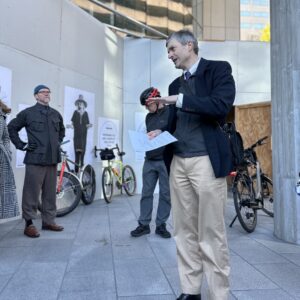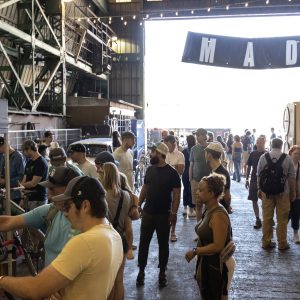The Oregon Department of Transportation (ODOT) is hosting an open house this Wednesday (3/19) to discuss the Newbury Vermont Bridges Rehabilitation Project.
This is the project that sparked interest in doing a “road diet” on Barbur that was ultimately rejected in favor of future traffic studies. While some saw the bridge rehab project as a golden opportunity to re-design Barbur, ODOT maintained that consideration of a road diet was beyond the scope. Instead, they opted to spend $180,000 to install four “Bikes on bridge” flashing warning signs that were turned on last week.
Wednesday’s open house is a chance to offer feedback on those signs and learn more about how the rehab project will impact traffic on Barbur Blvd.
ODOT plans to start the project April 21st with a series of lane closures. Here are more details about the closure plan (emphases mine):
… one lane in one direction on one bridge will be closed at a time. When a lane is closed on one bridge, the other will have all lanes open. The closures will be in place around the clock
.
No night work or weekend closures or detours are planned. All work will be done during the day unless an unexpected need for additional work hours arises
.
During daytime work, bicyclists will share a wider lane – 14 feet instead of 12 feet – with motorists. Evenings and weekends, the contractor, whenever feasible, will open a separated bike lane through the construction zone.Bridge walkways will be closed in one direction on each bridge and the Barbur Boulevard speed limit will be decrease from 45 mph to 35 mph, with increased enforcement.
It’s worth remembering that ODOT has repeatedly dismissed the road diet idea because they do not want to limit auto capacity or delay auto traffic on Barbur, which they say is a key alternate route to Interstate 5. However, in a previous statement about these construction plans, they admitted traffic “will not be significantly impacted” by the closures, especially over time as motorists adapt to the changes.”
Throw in the fact that traffic engineers from both Metro and Portland State University have disputed ODOT’s Barbur traffic analysis and it’s clear that a new, independent study is needed. While there was talk last fall about these construction closures being a good opportunity to model traffic impacts, some people say construction closures aren’t close enough to real-world conditions. ODOT has said the study should be done by Metro as part of the larger SW Corridor Plan process and PBOT Commissioner Steve Novick said he’d defer to (and support) whatever ODOT does.
At this point, it’s not clear who — if anyone — is actively working on a Barbur Blvd traffic study and/or whether that study will take place during this construction project. We’ll update this post if we receive any further clarifications.
The open house is scheduled for 5 p.m. to 7 p.m. at the Mittleman Jewish Community Center (6651 S.W. Capitol Hwy). Photo ID is required to enter the center.
Learn more about the Newbury Vermont bridges project at Oregon.gov.







Thanks for reading.
BikePortland has served this community with independent community journalism since 2005. We rely on subscriptions from readers like you to survive. Your financial support is vital in keeping this valuable resource alive and well.
Please subscribe today to strengthen and expand our work.
It would be interesting to do a comparison of number of open houses vs money spent on projects per neighborhoods. I bet SW would top the list. Maybe they could start a punch card deal or club card (you get a special snack if you show up to 10 or more meetings)
If that would at least get people there, I wish they’d try it. It is discouraging how few residents show up to these meetings. Those of us who do keep talking to the same few people. We are “preaching to the choir” because the ones who really need to show up don’t think they do. I think most people don’t understand the real risks to their loved ones until it happens… I was oblivious until then myself. It just wasn’t going to happen to anyone I love. Then it did.
In my limited experience, the city has not done a lot of outreach for publicizing open houses and other meetings. Honestly the few things I have attended have been solely because the meetings were publicized on this website.
I never have understood why they just don’t use temp road signs. Those would hit people who use the road most often.
I’m not able to attend but I do wonder if something like this would be helpful at slowing traffic down and making the road safer? Of course, if they’re balking at impeding the flow of auto traffic, it really sounds to me like they’re not interested in slowing vehicles down. Is it get them through no matter the cost? …”Speed triggers light” in Philly. http://mobile.philly.com/news/?wss=/philly/news&id=232422381
open houses… studies… smoke… mirrors… when is ODOT just going to do the right thing?
Until recently I had to bike across the Sylvan Overpass. After a number of close calls with motorists I complained to ODOT in an attempt to have the agency do something to improve the safety for cyclists and pedestrians at that point. A representative for ODOT contacted me and said that they would look into the problem and something would most likely be done within 12 months. Nothing was ever done and I never saw any evidence that any traffic studies were underway. It is a lack of response by ODOT that undermines its credibility as an agency concerned with the safety of non-motorized transportation. I expect that nothing significant will ever be done on the safety issues on Barbur Blvd. either until a few more injuries and deaths occur. Now I bike a short distance on Barbur each day and I do it with my fingers crossed.
I’m afraid I’ll never trigger those bikes on roadway lights… When I get into that area on a bicycle, I take the lane, the entire lane, and I don’t move back into the bike lane until I’ve cleared both bridges. I’m sick of people trying to squeeze past me and the car to my left because they think they have the room. Those road conditions are C**P and I need the room to avoid the potholes.
I should add that moving back into the bike lane after clearing the first bridge is like an invitation to cars back to try and overtake me just as I want to move back into the lane.
In comments to the March 7th bikeportland story about the flashing bike signs now operating on Barbur, a couple people have carefully noted the signs, the sensors’ placement and performance. They’ve offered suggestions about adjustments to the sign’s sensors to have them support a smooth, safe transition from bike lane to main lane and across the bridges:
http://bikeportland.org/2014/03/07/odots-first-ever-bicycle-warning-beacons-start-flashing-next-week-102600#comment-4582064
http://bikeportland.org/2014/03/07/odots-first-ever-bicycle-warning-beacons-start-flashing-next-week-102600#comment-4583932
More such comments, the better.
Wouldn’t it be interesting to study motor vehicle throughput during this planned construction project, at times when the number of lanes is reduced? I don’t pretend to know a good methodology, but isn’t there some idea we could get about what traffic would be like if a lane or two permanently went away?
Kittelson and associates did a study in 2012 on the traffic signal timing on 99W through Tigard, maybe they did one one this stretch as well.
When they close a lane of traffic, and traffic starts to back up, and people in cars see us chugging along on the side passing cars both up and downhill, they are going to hate us even more. When the road goes back to normal, we will have targets on our backs.
“Bikes think they are soooo special because they are not delayed by construction…”
I honestly doubt it will back up except at the heaviest peak times. I drive this way routinely, it backs up pretty bad at either end (Hamilton, Terwilliger) but there are usually clear lanes in between. Hurry up and wait!
So what is it going to take to get some of those people to say “Gee, maybe I should try cycling, I could be one of those people!”?
I would like to see a trail built just north a Brier to Slavin road… there is already work going on in the area, just need to drop a trail off Barbur to link up to it.
I’d like to bring it up at the meeting, but i’ll be out of town.
Why stop at Slavin? I’d like to see bike trail between Barbur and the freeway from Brier to Corbett. Slavin road used to run from the Capitol overpass to the Corbett neighborhood, but was almost impassably overgrown in its middle third. I used to ride my MTB on it.
This is actually part of the planned Red Electric Trail route and SW Trails is lobbying for that (find more on the Red electric trail on http://www.swtrails.org). The problem right now is not so much the useage of Slavin Road (the old Barbur blvd alignment) but a safe way to cross Barbur to get up to Terwilliger (this will be for both peds and bikes).
YES to Slavin! I used to live in Johns Landing and would have given up a nice set of wheels to have that connection, instead of having to ride through the morass at Hamilton. I tried riding my bike through it once, but it’s impassible. At the time it was also full of homeless camps, though I suspect that the current and neverending I-5 bridge project nearby cleaned them out.
Of course that still doesn’t solve the problem of the Vermont and Newbury bridges, but it would still be an improvement, especially for those connecting to/from South Waterfront or Johns Landing.
The other day I was driving on Barbur Blvd and it seemed to me that the “bike on roadway” light was on although I didn’t see a bicyclist. I was turning onto Capitol, so I might have overlooked the bike, but I was wondering if the light was triggered by a car veering into the bikelane, which probably happens regularly with cars turning onto Capitol. If the light is triggered without bikes being present it might desensitize car drivers after a while.
I had the impression from Steve Novick’s open letter last fall that PBOT would work with ODOT to study the road diet during this construction. Although, his language does not actually commit to anything:
“We do want to study the idea of a road diet (as well as other safety improvements on Barbur) and plan to do so. The Vermont and Newbury bridge repair project Oregon Department of Transportation has planned for this next summer can provide an excellent opportunity to see how traffic responds to reduced travel lanes during construction in real world conditions. I understand ODOT plans to measure the impact to Barbur, as well as nearby city streets. This data, combined with feedback from all of those traveling in the corridor, will help inform road diet deliberations. The Portland Bureau of Transportation will commit the time and resources to work with ODOT and engage the surrounding communities to see the impacts of a possible road diet and find the right solution.”
http://www.portlandoregon.gov/novick/article/466312
Since the existing bridges have a raised walkway, how hard is it for ODOT to just make the new sidewalk flush with the roadway. I live in the neighborhood and rarely see any pedestrian use of the bridges. It would be much easier to deal with the occasional person walking versus sharing that lane with a car.
Steve, I agree, and I would rather use the walkway on the bridges than have to take the lane, flashing lights or not. The sidewalks are structural elements of the bridge and cannot be lowered to the level of the bike lanes. However, the ramps from the bike lanes up to the walkways could be greatly improved (to the point of actually being rideable at speed), along with improvements to the railings. I believe this is actually in ODOT’s plans, even if a road diet (unfortunately) isn’t.
“…However, the ramps from the bike lanes up to the walkways could be greatly improved (to the point of actually being rideable at speed), …” GlowBoy
What distance from the bridges, would you think a ramp would need to start in order to allow a gradual enough climb to the sidewalk, for a speed of say 10-15 mph?
If a long ramp enabled people riding to climb and use the sidewalks for crossing the bridge, I wonder if a speed, over 10-15 mph, would be advisable for crossing in this manner.
Where did you come up with 10-15 mph? What mode of transportation? And what direction are you talking about?
The mode of travel being considered for using the sidewalks is bikes. The 10-15 mph speed I included as part of the question, was just one I thought of that may be reasonable, considering the width of the sidewalk across the bridges, and the degree of rise a different ramp might have. Does a different, more likely mph occur to you?
Even at 20mph, you wouldn’t need very much ramp length: 6-8 feet would be plenty. I base that on typical 3-4′ long curb cuts being easily rideable at any speed, and the bridge sidewalk being probably around twice the height of a normal curb.
Although the existing ramp length is a bit of a problem, the bigger problem is there is about a 2″ lip between the top of the ramp and the actual walkway, making it very tricky to take at speed.
It wouldn’t be too difficult to set up some temporary ramps of different lengths to see what would do the job.
By they way, if any of you check bikeportland’s twitter column, 20 hours ago, this tweet appeared:
” Jonathan Maus @BikePortland
.@OregonDOT says they’re “evaluating the timing and spacing of the triggers that activate the beacons” re: new flashing signs on Barbur ”
I clicked on the link that takes you to ODOT’s site here:
https://twitter.com/OregonDOT?original_referer=http%3A%2F%2Fbikeportland.org%2F2014%2F03%2F17%2Fgot-thoughts-about-barbur-blvd-tell-odot-at-open-house-wednesday-103082&profile_id=8073492&tw_i=446383458592382976&tw_p=embeddedtimeline&tw_w=321682781749002240
Didn’t see the notice about the evaluation listed there, but hopefully, I just overlooked it.
I will not be able to make the meeting due to a prior commitment, but there are two issues with the signs that need to be addressed (aside from the fact that it isn’t enough…).
1. The aforementioned distance to activate the signals. It’s just too close.
2. They are routinely getting activated by turning busses and swerving cars. I’ve seen them blinking over and over with no other cyclist in sight. This makes them as useless as the constant yellow blinking light that was up before.
I won’t be attending meeting, but it would be good to ask ODOT a couple of zingers:
What is the life cost of a fatality on SW Barbur (see if this lines up with US DOT valuations)
Given the previous fatalities on SW Barbur, how many more people have to die before they do some sort of traffic calming
Why not take the sidewalk?
“Why not take the sidewalk?” – Jim
See my note above. The ramps up to the sidewalk aren’t rideable in their current state. If the were, I personally would use them every time. There are almost never pedestrians on those walkways.
I have seen video of people riding that sidewalk in the oregonian.
By the way, I did email ODOT last week about the detector and beacon placement, and I just received a reply from the signal designer.
He acknowledged that this was their first project like this and that the initial 200′ distance was chosen based on field observations and basic analysis assuming a merge window of 4-5 seconds before reaching the bridges. They plan to do additional field observations, taking counts of where cyclists are moving over.
I’m inferring that they’re prepared to move the sensors if feedback warrants, but as for the beacon locations themselves he says they will be “monitored as feedback for future projects” – which I take to mean they don’t currently plan to move the beacons. That’s too bad, because I also question whether the beacons are far enough back for motorists to read them and react in time.
He also confirmed that ODOT will be improving the ramps and raising the railings in the upcoming project.
So it sounds like ODOT is listening to our feedback. Keep sending those emails!
I went to the open house last night and had some interesting conversations with a few folks.
First I went to the table designated as “Bicycles and Pedestrians.” Interestingly, one of the two ODOT employees behind that table was a woman wearing a distinctive skirt — I mention it because I had ridden behind her briefly yesterday morning. By this I knew that at least one ODOT person present was a bona fide bike commuter.
My goal from the meeting was to ensure the construction would be used to capture real, actionable data about a road diet. Not to do so just looked like a total waste to me. Talking to the woman at the table (my memory for names sucks), she showed me the locations they would be collecting data on traffic counts to determine how many people diverted. I reminded her that ODOT’s stated measure for opposing a road diet was travel time and asked whether they were measuring that; she didn’t know, and referred me to the area manager present, “Jeff [still can’t recall names well]”
Jeff was pleasant to talk with. Even without my bringing it up, he said they knew the northbound detector was too close and they were trying to work out where to put it so they don’t have to move it twice. Also he knows the buses are activating the southbound detector, and they’re looking at that. It’s nice to know they’re listening.
I asked him about measuring travel times and he immediately said yes, they absolutely were doing that. They’re measuring baseline (starting soon), then during each construction phase as they haven’t agreed which phase most closely resembles the road diet. So we will have data, for what it’s worth.
My next question to him stumped him though. I asked what the threshold was on a traffic delay for a road diet. He asked what I meant, so I clarified: let’s imagine you discovered there was zero delay…a road diet would work in that case for sure, right? (He agreed.) If it were 5 minutes’ delay per car, maybe not so much. What about five seconds…is that worth the lives that will be lost on these bridges as we both know they will? He provisionally allowed that 5 seconds didn’t seem so bad, but he was clear they hadn’t made a determination.
My concern about that is that if one is predisposed not to enact the road diet then it would be easy to measure the number and simply declare that it’s past the threshold…because the threshold gets set after the measurements. I told him that and he was at least open to the idea that I wasn’t paranoid. I asked who would set that number and he gave me a name which I did write down (because I *know* I can’t remember names). So now I know I need to contact Dennis Mitchell at ODOT before the construction starts and find out what the threshold is…and make sure it’s justifiable and public.
All in all I came away thinking they really want to *appear* bike-friendly, but I still fear that under the hood there may be limited substance to that. In any case the words last night were positive. I hope for actions to follow.